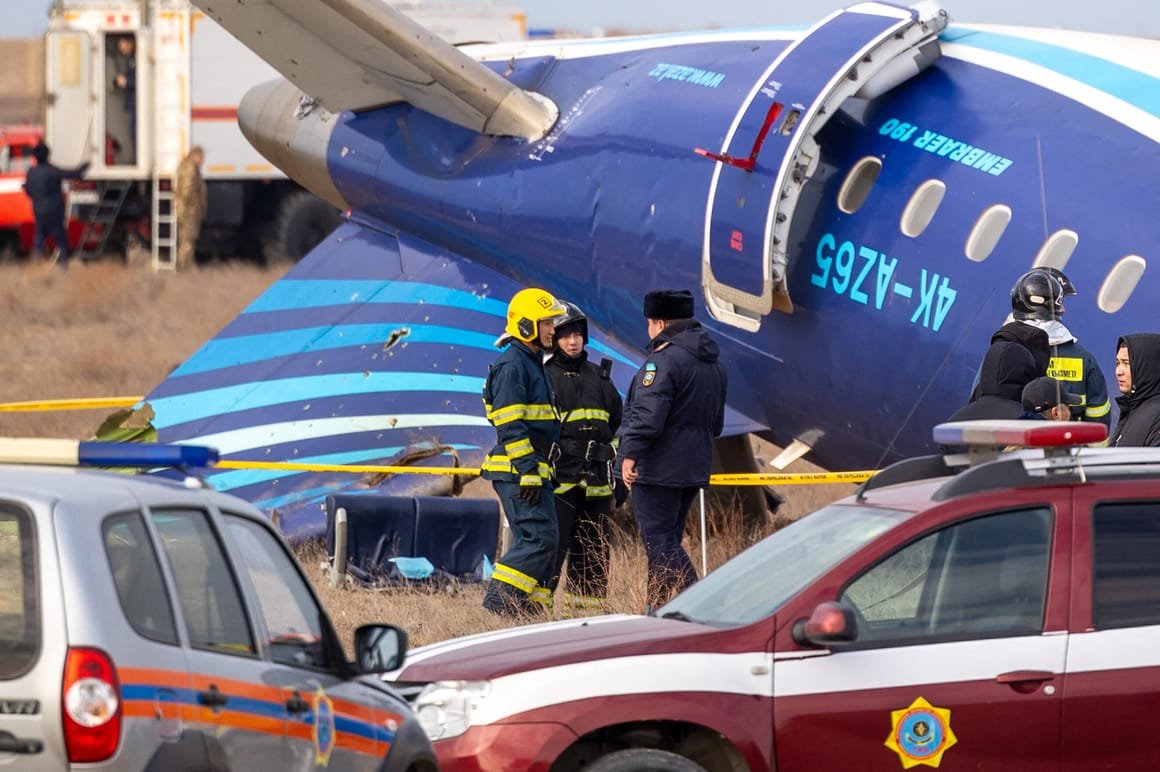Non-EU carriers that continue to fly over the country are expected to ignore the recommendation, however.

BRUSSELS — The European Union Aviation Safety Agency (EASA) has a message for airlines flying over Russia: Stop it.
It’s a response to the Christmas Day crash of Azerbaijan Airlines flight 8243 — which was likely shot down by a Russian air defense missile. Despite the urgency, however, the likelihood that non-EU carriers will listen to the regulator and end flights to Russian cities or through Russian airspace is close to nil.
Meanwhile, although the EASA warning is motivated by aviation safety, European airlines are complaining they’re having a tough time competing against non-European carriers offering cheaper airfares to Asia thanks to their ability to fly over Russia.
The Azerbaijani airliner that crashed Dec. 25 had been trying to land at Grozny, capital of the Russian region of Chechnya, which was under attack by Ukrainian drones.
Russian President Vladimir Putin offered a vague apology for the incident, but didn’t take responsibility for what happened — a response that infuriated his Azerbaijani counterpart, Ilham Aliyev, who is demanding justice.
Ukraine is building more missiles and drones with greater capabilities, and they are increasingly hitting military and economic targets deep inside Russia. Chechen leader Ramzan Kadyrov is a prominent Putin ally, and his soldiers are taking part in the war against Ukraine.
“The ongoing conflict following the Russian invasion of Ukraine poses the risk of civil aircraft being unintentionally targeted in the airspace of the Russian Federation, due to possible civil-military coordination deficiencies, and the potential for misidentification,” EASA said in a bulletin issued on Jan. 9.
EASA’s Conflict Zone Information Bulletin is aimed at non-European airlines that still operate in Russia. European carriers — along with those from the U.S. and many other countries that support Ukraine — have been blocked from Russian airspace since Moscow’s invasion of Ukraine in February 2022. The bulletin is advisory and is not a legal ban.
But non-EU airlines, which benefit from the exclusion of their European competitors from Russian airspace, are expected to ignore the new warning: Flying over Russia is simply too convenient and too profitable.
The Russian Federal Air Transport Agency (Rosaviatsia) called the ban “absurd” and said the European regulator was trying to restrict the number of Asian airlines overflying Russia. EASA, it said, “is simply trying to regain a competitive advantage for its companies.”
Avoid the west
The EU agency delineated a no-go zone for airlines covering all of western Russia — where about 80 percent of the country’s population lives — which would put Moscow, St. Petersburg, Kazan and Samara out of reach.
EASA advised airlines “not to operate within the affected airspace of the Russian Federation located west of longitude 60° East at all altitudes and flight levels.”
The move was necessary in light of the new unsafe environment, with more frequent combat taking place over Russian territory closest to Europe.
“The activation of Russian air defense systems, capable of operating at all altitudes, in response to Ukrainian missile and drone launches, which have extended deep inside Russian territory, may have a direct impact on flight operations at several locations, including major international airports,” the EU agency said.
The higher level of risk was demonstrated “by the [Dec. 25] incident involving Azerbaijan Airlines flight 8243.”
But experts doubt that non-EU airlines will pay much heed to EASA.
Business first
“Turkish, Middle Eastern and Chinese airlines are taking advantage of this and gaining market share,” said Wouter Dewulf, an air transport economist at the University of Antwerp.
EU-based airlines are at a disadvantage because avoiding Russia’s vast airspace costs them time and money for fuel and crew on flights between Europe and Asia.
“You have to count about $10,000 an hour [in] costs for a flight. That’s a lot of money,” Dewulf said, noting that this explains why EU airlines are either cutting Asian destinations or reducing the frequency of their flights.
He called the EASA recommendation “more a kind of political move rather than a real safety move.”
Even when it comes to flight safety, Dewulf found some ambiguity in the EASA bulletin.
“You have to make a distinction: Landing and taking off is, of course, more dangerous because then you can easily be hit by missiles and anti-aircraft systems,” he said, while overflying the area doesn’t pose the same problems.
“When flying at an altitude of 10 to 12 kilometres, you need a surface-to-air missile with highly advanced technology to successfully reach and target that flight.”
“Don’t forget that the European airlines now still fly over Iran, Afghanistan and even over Israel during certain periods,” he added.
That said, Malaysia Airlines Flight 17 was shot down by a Russian anti-aircraft missile over eastern Ukraine in 2014, killing all 298 people aboard. That prompted many airlines to reassess their policies on flying near conflict zones.
EASA’s no-go zone in western Russia was introduced “to send a signal, in the hope that some anti-competitive practices will stop. But these airlines will never stop flying over Russia,” Dewulf added.
Jan-Arwed Richter, CEO of JACDEC, a company that provides safety analyses for commercial aviation, agrees that non-EU airlines will ignore EASA.
“Maybe China will reconsider whether their airlines are supposed to go on flying through Russian airspace, but as far as I can foresee, the economics are likely to win at the end of the day,” he said.
“I still believe the vast majority of Russian airspace is safe for international air travel,” Richter added, “but its western and southern edges have become the acting ground for all sorts of military air-defense installations that are not fully reliable in properly identifying incoming traffic.”
European airline lobby A4E was more optimistic about the impact of the recommendation.
“I can’t speak for extra-EU airlines, but I trust and hope that all airlines, not just A4E members, will pay big attention to anything that raises safety and risk concerns,” said Ourania Georgoutsakou, managing director of A4E.
“I imagine that EASA will share this kind of recommendation with their partners around the world,” she added.
In the immediate aftermath of the Dec. 25 crash, some airlines, including Azerbaijan Airlines, Kazakhstan’s Qazaq Air and Israel’s El Al, limited flights to Russia. In the week since the EASA bulletin, however, no airline has said it would follow the agency’s recommendation.
Turkish Airlines, one of the carriers that continues to operate in Russia, did not immediately respond to a request for comment on the EASA recommendation.



